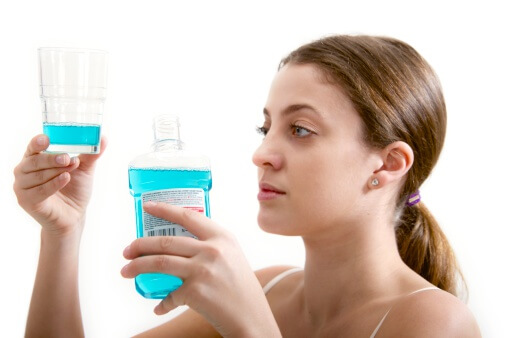The Health Benefits of Having a Dirty Mouth
8 years ago | Diabetes
By Joy Stephenson-Laws, JD, Founder
A proper dental hygiene routine usually involves three steps: floss, brush and mouthwash. But the last of these steps is causing some concern in the healthcare field.
Researchers at Harvard University found some evidence, which suggested that regular use of mouthwash may increase the risk of type 2 diabetes in people who are already at an increased risk for developing the disease.
The mouthwash study involved 1,206 overweight/obese individuals, aged 40–65 who did not have diabetes or major cardiovascular diseases. Complete data was available for 945 of the adults.
Forty-three percent of the participants used mouthwash at least once daily, while about 22% of the participants used mouthwash two times a day. After taking into consideration other factors, like additional oral hygiene steps, oral conditions and diet, researchers found (after a 3-year follow-up) that the participants who used mouthwash twice a day had a 55% higher risk of developing prediabetes and diabetes, compared to the participants who used mouthwash less frequently or did not use mouthwash at all.
According to the American Dental Association, there are two types of mouthwashes: cosmetic and therapeutic.
Cosmetic mouthwashes simply mask bad breath and may leave a pleasant taste in the mouth. They do not contain agents that actively kill bacteria in the mouth.
Therapeutic mouthwashes, like Listerine, are available over-the-counter (OTC), and some are prescribed. For example, if you have moderate to severe gingivitis (inflammation of the gums), your doctor may prescribe an oral rinse called chlorhexidine gluconate, which has strong antiseptic properties. Whether OTC or prescribed, therapeutic mouthwashes contain active ingredients which may help prevent or reduce bad breath, gingivitis, plaque, and tooth decay by killing bacteria in the mouth.
And just like your gut, your mouth contains both good and bad bacteria.
“More than 700 bacterial species or phylotypes, of which over 50% have not been cultivated, have been detected in the oral cavity,” according to the National Institutes for Health (NIH). “Surprisingly, little is known about the microflora of the healthy oral cavity.”
These therapeutic mouthwashes do not know how to selectively kill only the bad bacteria in the mouth, so they may end up killing good, protective bacteria in the mouth that may help prevent obesity and diabetes. One possibility is that killing good oral bacteria may alter blood sugar metabolism, especially in people who already have an increased risk of developing diabetes.
Additionally, an older study linked the use of mouthwash to higher blood pressure.
“We investigated whether suppression of the oral microflora affects systemic nitrite levels and hence blood pressure in healthy individuals,” the study reports.
Researchers measured blood pressure in 19 healthy people during an initial 7-day control period followed by a 7-day treatment period with a chlorhexidine-based antiseptic mouthwash.
“Antiseptic mouthwash treatment reduced oral nitrite production by 90% and plasma nitrite levels by 25% compared to the control period. Systolic and diastolic blood pressure increased by 2–3 .5 mm Hg, increases correlated to a decrease in circulating nitrite concentrations,” according to the study.
“The blood pressure effect appeared within 1 day of disruption of the oral microflora and was sustained during the 7-day mouthwash intervention. These results suggest that the recycling of endogenous nitrate by oral bacteria plays an important role in determination of plasma nitrite levels and thereby in the physiological control of blood pressure.”
More research is still needed, but these findings from both studies should perhaps make us all more proactive about not just our dental health but also our overall health.
I am not suggesting we all stay away from antiseptic mouthwashes, but if you are prediabetic, diabetic or have high blood pressure you may want to limit therapeutic mouthwash use to just one time a day, perhaps before bedtime. Consult with both your doctor and dentist, and you should be getting dental checkups and teeth cleanings every six to eight months to help prevent gum disease and tooth decay.
What else can you do to be proactive about your oral health
Like with most things regarding our health, you can always circle back to the importance of diet and nutrition.
Click here to learn more about how to reduce gum disease with critical nutrients. You may also want to consider using a periobiotic toothpaste. It is a specialized toothpaste, which reportedly has a probiotic that competes with the unhealthy strains of oral bacteria and helps maintain healthy gums.
Visit this link to know the new guidelines for what is considered hypertension (high blood pressure) and what nutrients you need to help manage blood pressure levels.
And finally, click here to learn more about how to reduce your risk of diabetes by consuming certain essential nutrients and maintaining a healthy diet.
Enjoy your healthy life!
The pH professional health care team includes recognized experts from a variety of healthcare and related disciplines, including physicians, attorneys, nutritionists, nurses and certified fitness instructors. This team also includes the members of the pH Medical Advisory Board, which constantly monitors all pH programs, products and services. To learn more about the pH Medical Advisory Board, click here.







